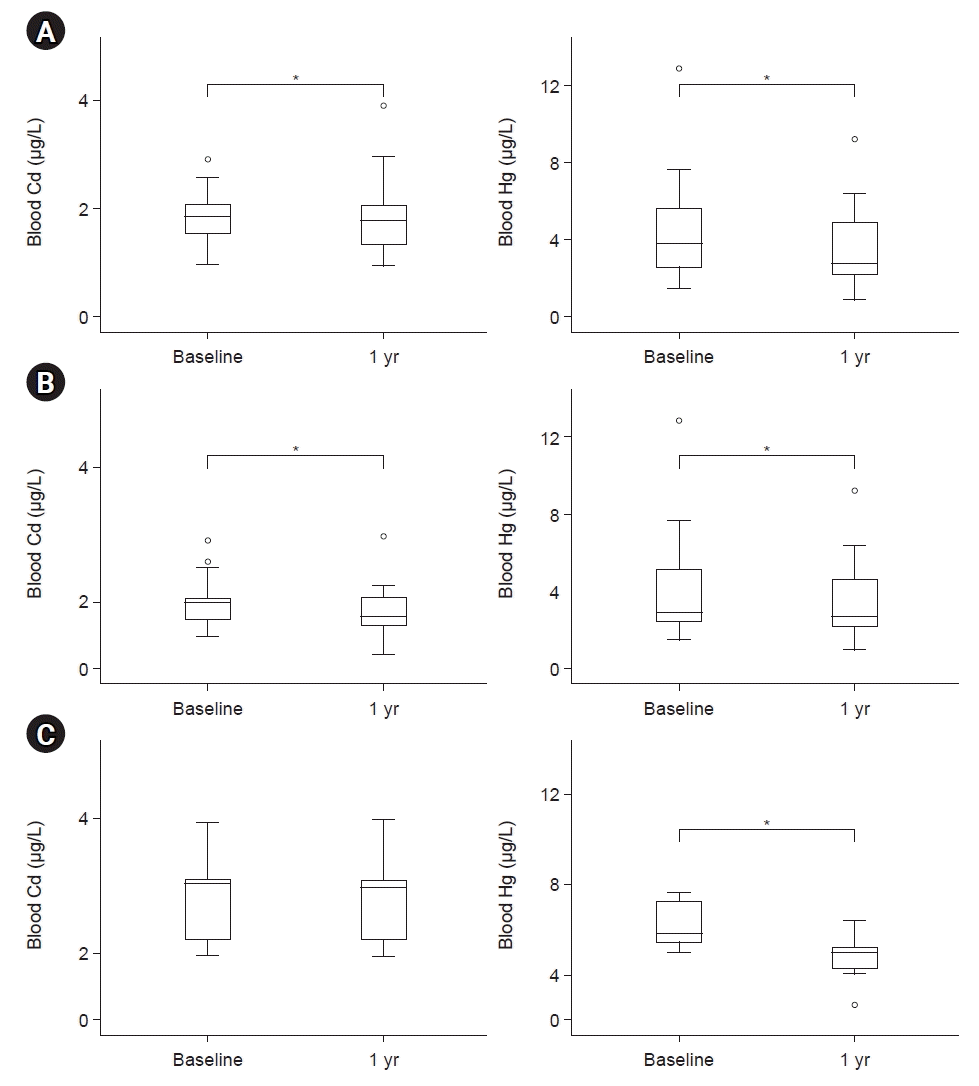1. Lunyera J, Mohottige D, Von Isenburg M, Jeuland M, Patel UD, Stanifer JW. CKD of uncertain etiology: a systematic review. Clin J Am Soc Nephrol. 2016; 11:379–85.
2. Jarup L, Berglund M, Elinder CG, Nordberg G, Vahter M. Health effects of cadmium exposure: a review of the literature and a risk estimate. Scand J Work Environ Health. 1998; 24 Suppl 1:1–51.
3. Jarup L, Akesson A. Current status of cadmium as an environmental health problem. Toxicol Appl Pharmacol. 2009; 238:201–8.
4. Faroon O, Ashizawa A, Wright S, Tucker P, Jenkins K, Ingerman L, et al. Toxicological profile for cadmium. Agency for Toxic Substances and Disease Registry (US); 2012.
5. Hsu CW, Yen TH, Chen KH, Lin-Tan DT, Lin JL, Weng CH, et al. Effect of blood cadmium level on mortality in patients undergoing maintenance hemodialysis. Medicine (Baltimore). 2015; 94:e1755.
6. Kim NH, Hyun YY, Lee KB, Chang Y, Ryu S, Oh KH, et al. Environmental heavy metal exposure and chronic kidney disease in the general population. J Korean Med Sci. 2015; 30:272–7.
7. Emanuelli T, Rocha JB, Pereira ME, Porciuncula LO, Morsch VM, Martins AF, et al. Effect of mercuric chloride intoxication and dimercaprol treatment on delta-aminolevulinate dehydratase from brain, liver and kidney of adult mice. Pharmacol Toxicol. 1996; 79:136–43.
8. Tanaka-Kagawa T, Suzuki M, Naganuma A, Yamanaka N, Imura N. Strain difference in sensitivity of mice to renal toxicity of inorganic mercury. J Pharmacol Exp Ther. 1998; 285:335–41.
9. Orr SE, Bridges CC. Chronic kidney disease and exposure to nephrotoxic metals. Int J Mol Sci. 2017; 18:1039.
10. Jalili C, Kazemi M, Cheng H, Mohammadi H, Babaei A, Taheri E, et al. Associations between exposure to heavy metals and the risk of chronic kidney disease: a systematic review and meta-analysis. Crit Rev Toxicol. 2021; 51:165–82.
11. Afrifa J, Essien-Baidoo S, Ephraim RK, Nkrumah D, Dankyira DO. Reduced egfr, elevated urine protein and low level of personal protective equipment compliance among artisanal small scale gold miners at Bibiani-Ghana: a cross-sectional study. BMC Public Health. 2017; 17:601.
12. Moon CS, Lee CK, Hong YS, Ikeda M. Higher cadmium burden in coastal areas than in inland areas in Korea: implications for seafood intake. Asia Pac J Clin Nutr. 2014; 23:219–24.
13. You CH, Kim BG, Jo EM, Kim GY, Yu BC, Hong MG, et al. The relationship between the fish consumption and blood total/methyl-mercury concentration of costal area in Korea. Neurotoxicology. 2012; 33:676–82.
14. U.S. Environmental Protection Agency (EPA). Method 7473 (SW-846): Mercury in Solids and Solutions by Thermal Decomposition, Amalgamation, and Atomic Absorption Spectrophotometry. EPA; 2000.
15. Seo JW, Hong YS, Kim BG. Assessment of lead and mercury exposure levels in the general population of Korea using integrated national biomonitoring data. Int J Environ Res Public Health. 2021; 18:6932.
16. Ministry of Health & Welfare. Clinical Laboratory Test for the Seventh Korea National Health and Nutrition Examination Survey (2016-2018). Ministry of Health & Welfare; 2019.
17. Mahaffey KR, Clickner RP, Bodurow CC. Blood organic mercury and dietary mercury intake: National Health and Nutrition Examination Survey, 1999 and 2000. Environ Health Perspect. 2004; 112:562–70.
18. McKelvey W, Gwynn RC, Jeffery N, Kass D, Thorpe LE, Garg RK, et al. A biomonitoring study of lead, cadmium, and mercury in the blood of New York city adults. Environ Health Perspect. 2007; 115:1435–41.
19. Schober SE, Sinks TH, Jones RL, Bolger PM, McDowell M, Osterloh J, et al. Blood mercury levels in US children and women of childbearing age, 1999-2000. JAMA. 2003; 289:1667–74.
20. Barchiesi F, Branciari R, Latini M, Roila R, Lediani G, Filippini G, et al. Heavy metals contamination in shellfish: benefit-risk evaluation in Central Italy. Foods. 2020; 9:1720.
21. Mok JS, Kwon JY, Son KT, Choi WS, Kim PH, Lee TS, et al. Distribution of heavy metals in internal organs and tissues of Korean molluscan shellfish and potential risk to human health. J Environ Biol. 2015; 36:1161–7.
22. Yang H, Shu Y. Cadmium transporters in the kidney and cadmium-induced nephrotoxicity. Int J Mol Sci. 2015; 16:1484–94.
23. Nordberg M, Jin T, Nordberg GF. Cadmium, metallothionein and renal tubular toxicity. IARC Sci Publ. 1992; (118):293–7.
24. Thevenod F. Nephrotoxicity and the proximal tubule: insights from cadmium. Nephron Physiol. 2003; 93:87–93.
25. Bridges CC, Joshee L, Zalups RK. Multidrug resistance proteins and the renal elimination of inorganic mercury mediated by 2,3-dimercaptopropane-1-sulfonic acid and meso-2,3-dimercaptosuccinic acid. J Pharmacol Exp Ther. 2008; 324:383–90.
26. Gritzka TL, Trump BF. Renal tubular lesions caused by mercuric chloride. Electron microscopic observations: degeneration of the pars recta. Am J Pathol. 1968; 52:1225–77.
27. Chapter 1: Definition and classification of CKD. Kidney Int Suppl (2011). 2013; 3:19–62.
28. Imai E, Horio M, Yamagata K, Iseki K, Hara S, Ura N, et al. Slower decline of glomerular filtration rate in the Japanese general population: a longitudinal 10-year follow-up study. Hypertens Res. 2008; 31:433–41.
29. Hemmelgarn BR, Zhang J, Manns BJ, Tonelli M, Larsen E, Ghali WA, et al. Progression of kidney dysfunction in the community-dwelling elderly. Kidney Int. 2006; 69:2155–61.
30. Cherian MG, Hursh JB, Clarkson TW, Allen J. Radioactive mercury distribution in biological fluids and excretion in human subjects after inhalation of mercury vapor. Arch Environ Health. 1978; 33:109–14.





 PDF
PDF Citation
Citation Print
Print



 XML Download
XML Download